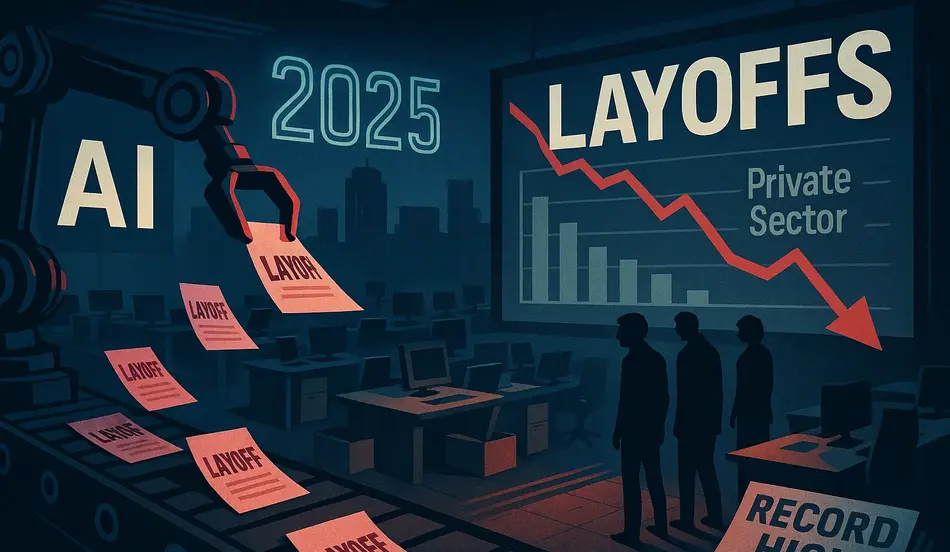The AI Job Cuts 2025 Crisis: A Record-Breaking Trend
The AI job cuts 2025 phenomenon has created a watershed moment in American employment history, with private sector layoffs reaching levels not seen since the height of the COVID-19 pandemic. The Challenger, Gray & Christmas report reveals that July’s job cuts exceeded 10,000 positions, marking a significant acceleration in workforce restructuring that has been building throughout the year.
This dramatic increase in AI job cuts 2025 represents a fundamental shift in how businesses approach workforce management and technological integration. Companies are increasingly viewing artificial intelligence not as a complementary tool but as a replacement for human labor in various sectors, creating unprecedented challenges for workers across multiple industries.
The Technology Sector’s Devastating Impact
The AI job cuts 2025 crisis has hit the technology industry particularly hard, with over 89,000 positions eliminated in this sector alone. This represents a staggering 36% increase compared to the same period last year, demonstrating the rapid pace at which AI integration is transforming the tech workforce.
Technology companies, traditionally seen as drivers of employment growth, are now leading the charge in workforce reduction as they prioritize AI implementation over human capital investment. This shift has created a paradox where the very companies developing AI technologies are also the ones most aggressively eliminating jobs through their deployment.
The Dual Threat: AI and Tariff Pressures
The AI job cuts 2025 crisis is being driven by two interconnected forces that are creating unprecedented pressure on American businesses. Companies are increasingly attributing their layoff decisions to both tariff pressures and AI development, creating a complex economic environment where multiple factors are contributing to workforce reduction.
The combination of trade policy uncertainty and technological advancement has created a perfect storm that is forcing businesses to make difficult decisions about workforce size and composition. The AI job cuts 2025 trend reflects a broader economic reality where companies must adapt to both policy changes and technological disruption simultaneously.
The Tariff Impact on Employment
Tariff pressures have emerged as a significant factor contributing to the AI job cuts 2025 crisis, as businesses face increased costs and supply chain disruptions that force them to seek efficiency gains through automation. The uncertainty surrounding trade policy has created an environment where companies are more willing to invest in AI solutions that can reduce labor costs and improve operational efficiency.
This economic pressure has accelerated the adoption of AI technologies that might otherwise have been implemented more gradually, creating a surge in job cuts that reflects both immediate economic necessity and long-term strategic planning.
The AI Replacement Reality: 27,000 Jobs Lost
The AI job cuts 2025 crisis has reached a critical milestone, with over 27,000 positions directly replaced by artificial intelligence since 2023. This statistic represents a fundamental shift in the employment landscape, where AI has emerged as one of the five main causes of unemployment this year.
The direct replacement of human workers by AI systems represents a new phase in the technological revolution, where artificial intelligence is no longer simply augmenting human capabilities but actively displacing workers across multiple industries. This trend has profound implications for the future of work and the structure of the American economy.
The Industries Most Affected
The AI job cuts 2025 crisis is affecting industries across the economic spectrum, with no sector immune to the disruptive effects of artificial intelligence. While technology companies are experiencing the most dramatic cuts, other sectors including manufacturing, retail, and professional services are also seeing significant workforce reductions.
This broad-based impact suggests that the AI job cuts 2025 phenomenon is not a temporary trend but a fundamental restructuring of the American workforce that will continue to evolve as AI technologies become more sophisticated and widespread.
Looking to Hire Fast?
Hiring managers can now post jobs for free on WhatJobs and connect with millions of jobseekers.
👉 Post a Job Now →The Immigration Program Paradox
Amid the AI job cuts 2025 crisis, an interesting paradox has emerged in the immigration landscape. While American workers are facing unprecedented job losses due to AI restructuring, the existing investment-based residency program EV5 has seen record applications from India over the past year.
This development suggests that despite the AI job cuts 2025 trend, the United States remains an attractive destination for international investors and entrepreneurs. The American Immigrant Investor Alliance reports that the EV5 program, which will be replaced by the new gold card program, has experienced unprecedented interest from Indian applicants.
The Gold Card Program Anticipation
The anticipation surrounding the new gold card program has created additional complexity in the immigration landscape, even as the AI job cuts 2025 crisis continues to unfold. While specific details and launch dates remain undisclosed, the program’s development suggests that the United States is seeking to balance workforce disruption with continued international investment and talent attraction.
This dual approach reflects the complex nature of the current economic environment, where technological disruption and international competition are creating competing pressures on American economic policy.
The Economic Implications of AI Job Cuts 2025
The AI job cuts 2025 crisis has profound economic implications that extend far beyond the immediate loss of employment. This trend is fundamentally altering the structure of the American economy, creating new challenges for policymakers, businesses, and workers alike.
The rapid pace of AI integration is creating a mismatch between the skills required by the evolving economy and the skills possessed by the current workforce. This skills gap is contributing to the AI job cuts 2025 phenomenon as companies struggle to find workers with the necessary expertise to work alongside or manage AI systems.
The Skills Gap Challenge
The AI job cuts 2025 crisis is highlighting a critical skills gap in the American workforce that is contributing to both job losses and hiring difficulties. As companies increasingly rely on AI systems, they require workers with specialized knowledge in AI management, data analysis, and system integration.
This skills gap is creating a paradoxical situation where companies are cutting jobs due to AI implementation while simultaneously struggling to find workers with the expertise needed to maximize AI effectiveness. The AI job cuts 2025 trend reflects this complex dynamic.
The Future of Work in the AI Era
The AI job cuts 2025 crisis represents a fundamental shift in the nature of work that will continue to evolve in the coming years. This trend suggests that the future of employment will be characterized by increased automation, changing skill requirements, and new forms of human-AI collaboration.
The rapid pace of AI job cuts 2025 indicates that businesses are moving quickly to adapt to the new technological landscape, often prioritizing efficiency and cost reduction over workforce stability. This approach is creating both opportunities and challenges for workers and businesses alike.
Adaptation Strategies for Workers
Workers affected by the AI job cuts 2025 crisis must develop new strategies for career success in an increasingly automated economy. This includes developing skills that complement rather than compete with AI systems, focusing on areas where human creativity, emotional intelligence, and strategic thinking remain essential.
The AI job cuts 2025 trend suggests that successful workers will be those who can effectively collaborate with AI systems while maintaining the unique human capabilities that cannot be easily automated.
The Policy Response to AI Job Cuts 2025
The AI job cuts 2025 crisis has created new challenges for policymakers who must balance technological advancement with workforce protection. This trend requires innovative policy responses that address both the immediate needs of displaced workers and the long-term requirements of an AI-driven economy.
Policy responses to the AI job cuts 2025 crisis must include comprehensive retraining programs, enhanced unemployment benefits, and new approaches to education that prepare workers for the evolving job market. The scale and pace of AI integration require policy solutions that are both immediate and forward-looking.
Retraining and Education Initiatives
Addressing the AI job cuts 2025 crisis requires significant investment in retraining and education initiatives that help workers develop the skills needed for the new economy. This includes both formal education programs and on-the-job training opportunities that bridge the gap between current skills and future requirements.
The AI job cuts 2025 trend suggests that traditional approaches to workforce development may be insufficient for the challenges posed by rapid technological change. New models of education and training are needed to prepare workers for the AI era.
The Global Context of AI Job Cuts 2025
The AI job cuts 2025 crisis is not unique to the United States, but represents a global trend that is affecting economies worldwide. This international context provides important insights into how different countries are responding to the challenges of AI integration and workforce disruption.
The global nature of the AI job cuts 2025 phenomenon suggests that this is not a temporary economic adjustment but a fundamental transformation of work that will continue to evolve across international borders. Understanding this global context is essential for developing effective policy responses.
International Comparisons and Lessons
Examining how other countries are responding to AI job cuts 2025 provides valuable insights for American policymakers and business leaders. Different approaches to AI integration, workforce development, and social safety nets offer important lessons for addressing the challenges of technological disruption.
The AI job cuts 2025 crisis in the United States is part of a broader global trend that requires international cooperation and shared learning to develop effective solutions.
The Long-Term Outlook for Employment
The AI job cuts 2025 crisis suggests that the employment landscape will continue to evolve rapidly in the coming years. While the immediate impact is characterized by job losses, the long-term outlook may include new opportunities for workers who can adapt to the changing technological environment.
The AI job cuts 2025 trend represents a transitional period in the evolution of work, where traditional employment models are being replaced by new approaches that emphasize human-AI collaboration and specialized skills. This transition will create both challenges and opportunities for workers and businesses.
Emerging Opportunities in the AI Era
Despite the immediate challenges posed by AI job cuts 2025, new opportunities are emerging for workers who can develop the skills needed for the AI era. These opportunities include roles in AI management, data analysis, system integration, and areas where human creativity and emotional intelligence remain essential.
The AI job cuts 2025 crisis is creating a new employment landscape that will reward workers who can effectively navigate the intersection of human capabilities and artificial intelligence.
Frequently Asked Questions
Q: What is causing the AI job cuts 2025 crisis?
A: The AI job cuts 2025 crisis is being driven by accelerated artificial intelligence restructuring, tariff pressures, and companies seeking efficiency gains through automation. Over 27,000 jobs have been directly replaced by AI since 2023.
Q: Which industries are most affected by AI job cuts 2025?
A: The technology industry has been hardest hit by AI job cuts 2025, with over 89,000 positions eliminated, representing a 36% increase from last year. However, the crisis is affecting multiple sectors including manufacturing, retail, and professional services.
Q: How can workers adapt to the AI job cuts 2025 trend?
A: Workers can adapt to AI job cuts 2025 by developing skills that complement AI systems, focusing on areas where human creativity and emotional intelligence remain essential, and pursuing retraining opportunities in AI management and data analysis.




